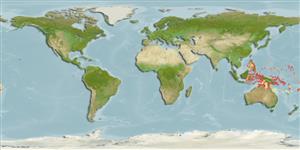>
Eupercaria/misc (Various families in series Eupercaria) >
Nemipteridae (Threadfin breams, Whiptail breams)
Etymology: Scolopsis: Greek, skolex = worm + Greek, opsis = appearance (Ref. 45335).
More on author: Cuvier.
Environment: milieu / climate zone / depth range / distribution range
Ecologie
marien rifbewoner; diepte ? - 35 m (Ref. 90102). Tropical; 19°N - 23°S, 115°E - 176°W
Western Pacific: Eastern Indonesia, Solomon Islands, Santa Cruz Islands and Fiji. This species closely resembles Scolopsis monogramma, and the two species have been previously confused.
Grootte / Gewicht / Leeftijd
Maturity: Lm ? range ? - ? cm
Max length : 35.0 cm SL mannelijk / geslacht onbekend; (Ref. 48635); common length : 20.0 cm SL mannelijk / geslacht onbekend; (Ref. 3810)
Dorsale stekels (totaal): 10; Dorsale zachte stralen (totaal): 9; Anale stekels 3; Anale zachte stralen: 7. Head scales reaching forward to or just behind level of anterior margin of eye. A small naked area on temporal region behind eye. Lower limb of preopercle scaly. Antrorse (forward-directed) suborbital spine absent. Pelvic fins long, reaching to or beyond level of anus. Upper lobe of caudal fin a little longer then lower lobe. Lobes produced to form filamentous extensions in larger specimens. Color: Upper body bluish, white below. Sides are also bluish. Scales on body with yellow centers forming horizontal lines above lateral line and diagonal lines below. A pinkish-brown stripe from behind eye, arching on back beneath lateral line and terminating behind tip of pectoral fin. Four blue stripes on head.
Inhabits coastal and lagoon waters, on sand rubble bottoms close to reefs. Usually seen solitary in 20+ m depth. May also be seen in groups. (Ref. 48635, 90102)
Levenscyclus en paargedrag
Maturiteit | Voortplanting | Paaien | Eieren | Fecunditeit | Larven
Russell, B.C., 1990. FAO Species Catalogue. Vol. 12. Nemipterid fishes of the world. (Threadfin breams, whiptail breams, monocle breams, dwarf monocle breams, and coral breams). Family Nemipteridae. An annotated and illustrated catalogue of nemipterid species known to date. FAO Fish. Synop. 125(12):149p. Rome: FAO. (Ref. 3810)
Status op de Rode Lijst van het IUCN (Ref. 130435)
Gevaar voor de mens
Harmless
Gebruik door de mens
Visserij: visserij voor eigen gebruik
Meer informatie
Lokale namenSynoniemenMetabolismePredatorenEcotoxicologieVoortplantingMaturiteitPaaienPaaiaggregatiesFecunditeitEierenOntwikkeling van de eieren
ReferentiesAquacultuurAquacultuurprofielKweeklijnenGeneticaElectrophoresesErfelijkheidZiektesVerwerkingNutrientsMassaconversie
Tools
Speciale rapporten
Download XML
Internetbronnen
Estimates based on models
Preferred temperature (Ref.
123201): 27.3 - 29.3, mean 28.8 °C (based on 1018 cells).
Fylogenetische diversiteitsindex (Ref.
82804): PD
50 = 0.5000 [Uniqueness, from 0.5 = low to 2.0 = high].
Bayesian length-weight: a=0.01514 (0.00838 - 0.02734), b=2.96 (2.81 - 3.11), in cm total length, based on LWR estimates for this species & Genus-body shape (Ref.
93245).
Trofisch niveau (Ref.
69278): 3.5 ±0.37 se; based on food items.
Weerstandsvermogen (Ref.
120179): Gemiddeld, minimale populatieverdubbelingstijd 1,4-4,4 jaar (Preliminary K or Fecundity.).
Fishing Vulnerability (Ref.
59153): Low to moderate vulnerability (33 of 100).
Nutrients (Ref.
124155): Calcium = 47.9 [29.8, 94.0] mg/100g; Iron = 0.597 [0.298, 1.473] mg/100g; Protein = 19 [17, 21] %; Omega3 = 0.139 [0.084, 0.230] g/100g; Selenium = 28.6 [17.2, 50.0] μg/100g; VitaminA = 75.2 [21.1, 210.5] μg/100g; Zinc = 1.21 [0.85, 1.73] mg/100g (wet weight);
